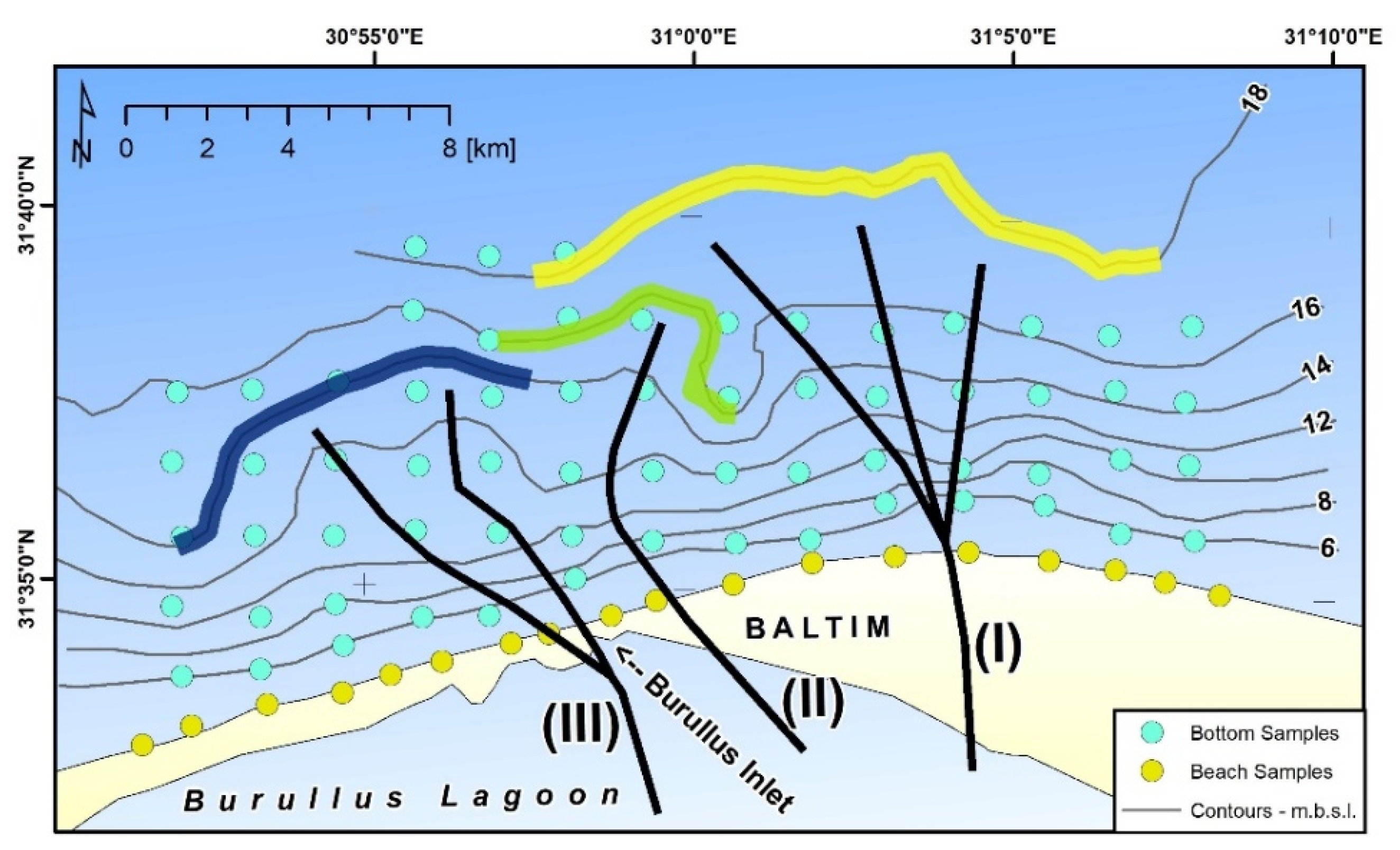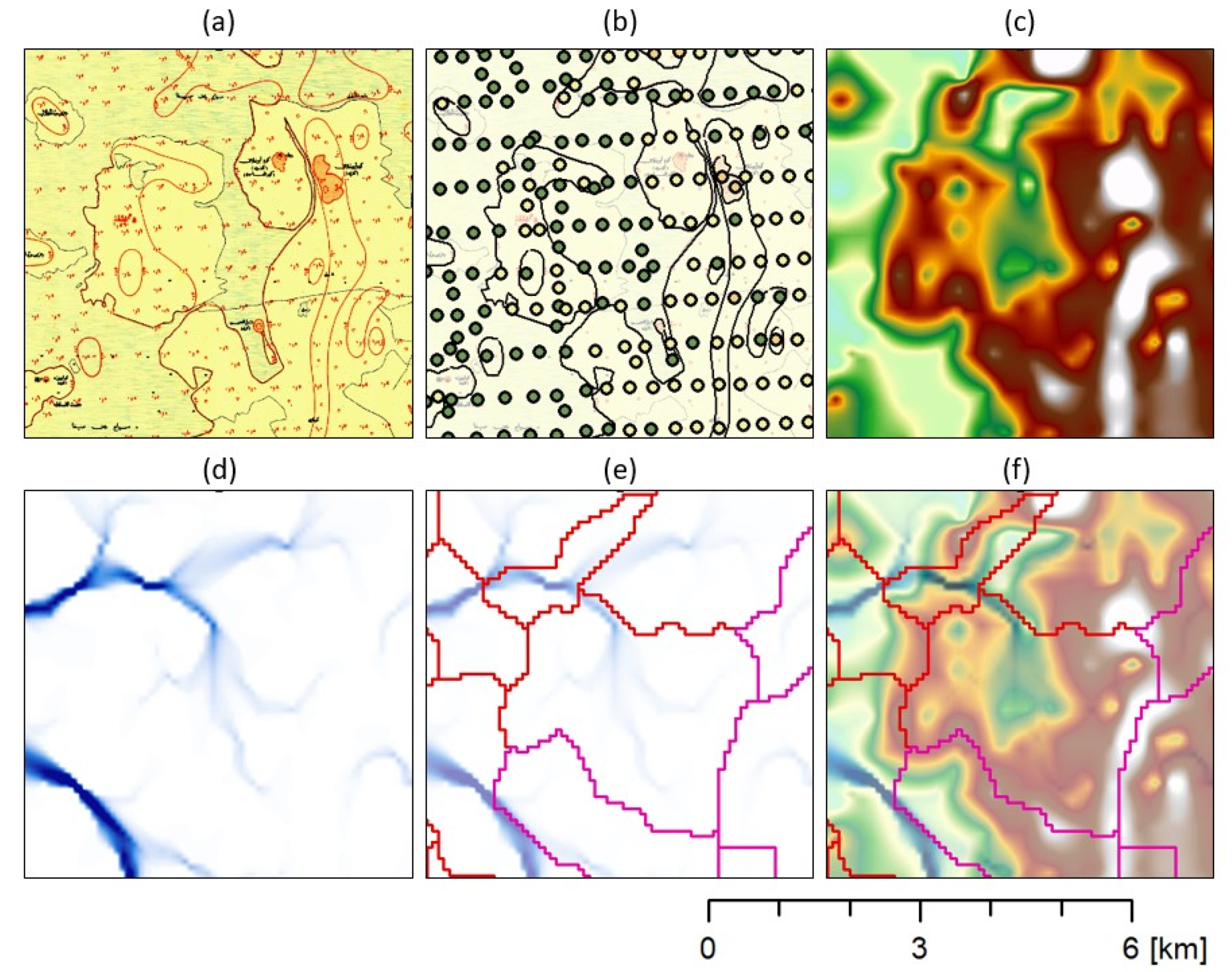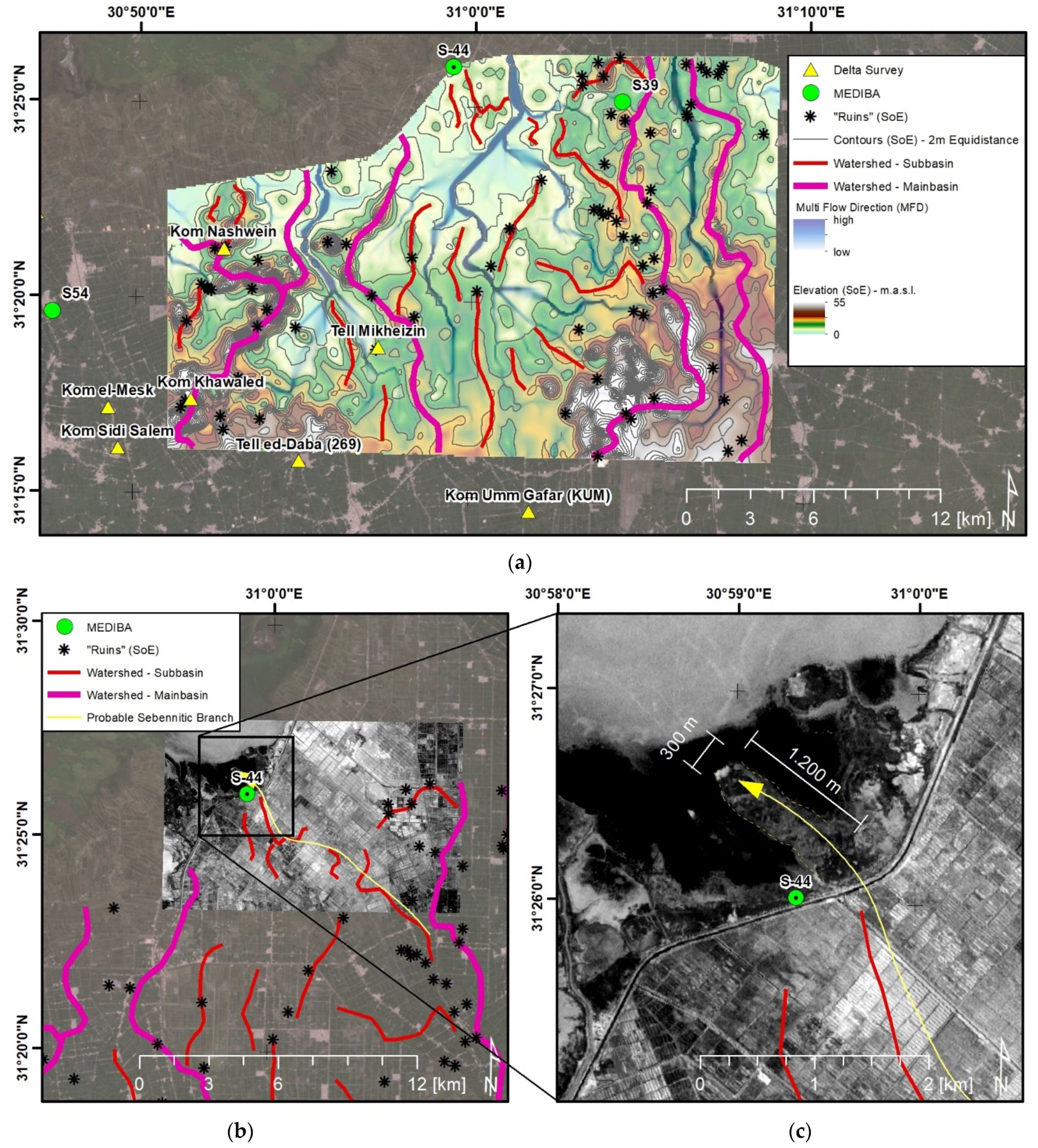Holocene Aridity-Induced Interruptions of Human Activity along a Fluvial Channel in Egypt’s Northern Delta
Abstract
:1. Introduction
2. Materials and Methods
2.1. Paleogeographic Setting of Study Area
2.2. Topographic Maps and Satellite Imagery
3. Results
3.1. Satellite Imagery, Topographic Maps, and Hydrographic Modeling
3.2. Archaeological Record in Core S-44
4. Discussion
5. Conclusions
Author Contributions
Funding
Institutional Review Board Statement
Informed Consent Statement
Data Availability Statement
Acknowledgments
Conflicts of Interest
References
- Herodotus; Grene, D. The History; University of Chicago Press: Chicago, IL, USA, 1987; 699p, ISBN 0-226-32772-8. [Google Scholar]
- Sestini, G. Implications of climatic changes for the Nile Delta. In Climatic Change and the Mediterranean; Jeftic, L., Milliman, J.D., Sestini, G., Eds.; Arnold: London, UK, 1992; Volume 1, pp. 535–601. [Google Scholar]
- United Nations Development Program (UNDP/UNESCO) Coastal Protection Studies. In Arab Republic of Egypt: UNDP/EGY/73/063 Final Technical Report, United Nations Educational, Scientific and Cultural Organization; United Nations Development Program: Paris, France, 1978; p. 438.
- Said, R. The Geological Evolution of the River Nile; Springer: New York, NY, USA, 1981. [Google Scholar]
- Toussoun, O. Mémoire sur les Anciennes Branches du Nil: Époque Ancienne; Impr. de l’Institut Français d’Archéologie Orientale: Le Caire, Egypt, 1922. [Google Scholar]
- Stanley, D.J.; Arnold, D.; Warne, A.G. Oldest Pharaonic Site yet Discovered in the North-Central Nile Delta, Egypt. Natl. Geogr. Res. Explor. 1992, 8, 264–275. [Google Scholar]
- Stanley, J.-D.; Warne, A.G.; Davis, H.R.; Bernasconi, M.P.; Chen, Z. Nile Delta. Natl. Geogr. Res. Explor. 1992, 8, 22–51. [Google Scholar]
- Butzer, K.W. Early Hydraulic Civilization in Egypt: A Study in Cultural Ecology; Prehistoric Archeology and Ecology; The University of Chicago Press: Chicago, IL, USA, 1976; ISBN 978-0-226-08635-4. [Google Scholar]
- Stanley, D.J.; Warne, A.G. Nile Delta: Recent Geological Evolution and Human Impact. Science 1993, 260, 628–634. [Google Scholar] [CrossRef]
- Frihy, O.E.; Debes, E.A.; El Sayed, W.R. Processes reshaping the Nile delta promontories of Egypt: Pre- and post-protection. Geomorphology 2003, 53, 263–279. [Google Scholar] [CrossRef]
- Arbouille, D.; Stanley, D.J. Late Quaternary evolution of the Burullus lagoon region, north-central Nile delta, Egypt. Mar. Geol. 1991, 99, 45–66. [Google Scholar] [CrossRef]
- El-Asmar, H.M.; Hereher, M.E.; El Kafrawy, S.B. Surface area change detection of the Burullus Lagoon, North of the Nile Delta, Egypt, using water indices: A remote sensing approach. Egypt. J. Remote Sens. Space Sci. 2013, 16, 119–123. [Google Scholar] [CrossRef] [Green Version]
- Frihy, O.E.; Lotfy, M.F. Mineralogic evidence for the remnant Sebennitic promontory on the continental shelf off the central Nile delta. Mar. Geol. 1994, 117, 187–194. [Google Scholar] [CrossRef]
- Frihy, O.; Deabes, E. Beach and Nearshore Morphodynamics of the Central-Bulge of the Nile Delta Coast, Egypt. Int. J. Environ. Prot. 2011, 1, 33–46. [Google Scholar]
- Frihy, O.E. Nile Delta shoreline changes: Aerial photographic study of a 28-year period. J. Coast. Res. 1988, 4, 597–606. [Google Scholar]
- El Banna, M.M. Nature and human impact on Nile Delta coastal sand dunes, Egypt. Environ. Earth Sci. 2004, 45, 690–695. [Google Scholar] [CrossRef]
- Hossen, H.; Negm, A. Change detection in the water bodies of Burullus Lake, Northern Nile Delta, Egypt, using RS/GIS. Procedia Eng. 2016, 154, 951–958. [Google Scholar] [CrossRef]
- Gebremichael, E.; Sultan, M.; Becker, R.; El Bastawesy, M.; Cherif, O.; Emil, M. Assessing Land deformation and sea encroachment in the Nile Delta: A radar interferometric and inundation modeling approach. J. Geophys. Res. Solid Earth 2018, 123, 3208–3224. [Google Scholar] [CrossRef]
- El Bastawesy, M.; Gebremichael, E.; Sultan, M.; Attwa, M.; Sahour, H. Tracing Holocene channels and landforms of the Nile Delta through integration of early elevation, geophysical, and sediment core data. Holocene 2020, 30, 1129–1141. [Google Scholar] [CrossRef] [Green Version]
- Stanley, D.J.; McRea, J.E.; Waldron, J.C. Nile Delta drill core and sample database for 1985-1994: Mediterranean Basin (MEDIBA) Program. Smithson. Contrib. Mar. Sci. 1996, 37, 1–428. [Google Scholar] [CrossRef]
- Butzer, K.W. Geoarchaeological implications of recent research in the Nile Delta. In Egypt and the Levant: Interrelations from the 4th through the Early 3rd Millennium BCE; Van den Brink, E.C.M., Levy, T.E., Eds.; Leicester University Press: London, UK; New York, NY, USA, 2002; pp. 83–97. [Google Scholar]
- Hereher, M.E. Vulnerability of the Nile Delta to sea level rise: An assessment using remote sensing. Geomat. Nat. Hazards Risk 2010, 1, 315–321. [Google Scholar] [CrossRef]
- El-Hattab, M.M. Improving Coastal Vulnerability Index of the Nile Delta Coastal Zone, Egypt. J. Earth Sci. Clim. Chang. 2015, 6, 06. [Google Scholar] [CrossRef]
- El-Geziry, T.M. On the vulnerability of the Egyptian Mediterranean Coast to the sea level rise. Athens J. Sci. 2020, 7, 195–206. [Google Scholar] [CrossRef]
- Hasan, E.; Khan, S.I.; Hong, Y. Investigation of potential sea level rise impact on the Nile Delta, Egypt using digital elevation models. Environ. Monit. Assess. 2015, 187, 649. [Google Scholar] [CrossRef] [PubMed]
- Stanley, J.-D.; Clemente, P.L. Increased land subsidence and sea-level rise are submerging Egypt’s Nile Delta coastal margin. GSA Today 2017, 4–11. [Google Scholar] [CrossRef] [Green Version]
- Stanley, J.-D.; Corwin, K.A. Measuring strata thicknesses in cores to assess recent sediment compaction and subsidence of Egypt’s Nile Delta coastal margin. J. Coast. Res. 2013, 288, 657–670. [Google Scholar] [CrossRef]
- Korrat, I.; El Agami, N.; Hussein, H.; El-Gabry, M. Seismotectonics of the passive continental margin of Egypt. J. Afr. Earth Sci. 2005, 41, 145–150. [Google Scholar] [CrossRef]
- Mohamed, A.E.-E.A.; Elhadidy, M.; Deif, A.; Elenean, K.A. Seismic hazard studies in Egypt. NRIAG J. Astron. Geophys. 2012, 1, 119–140. [Google Scholar] [CrossRef] [Green Version]
- Kebeasy, R.M. Seismicity. In The Geology of Egypt: Rotterdam; Said, R., Ed.; A.A. Balkama: Rotterdam, The Netherlands, 1990; pp. 51–59. [Google Scholar]
- Ullmann, T.; Lange-Athinodorou, E.; Göbel, A.; Büdel, C.; Baumhauer, R. Preliminary results on the paleo-landscape of Tell Basta/Bubastis (eastern Nile delta): An integrated approach combining GIS-Based spatial analysis, geophysical and archaeological investigations. Quat. Int. 2019, 511, 185–199. [Google Scholar] [CrossRef]
- Gruber, S.; Peckham, S. Chapter 7 Land-Surface parameters and objects in hydrology. In Developments in Soil Science; Hengl, T., Reuter, H.I., Eds.; Geomorphometry; Elsevier: Amsterdam, The Netherlands, 2009; Volume 33, pp. 171–194. [Google Scholar]
- Wang, L.; Liu, H. An efficient method for identifying and filling surface depressions in digital elevation models for hydrologic analysis and modelling. Int. J. Geogr. Inf. Sci. 2006, 20, 193–213. [Google Scholar] [CrossRef]
- Wilson, P. Landscapes of the Bashmur: Settlements and monasteries in the northern Egyptian Delta from the seventh to the ninth century. In The Nile: Natural and Cultural Landscape in Egypt; Willems, H., Dahms, J.-M., Eds.; Transcript Verlag: Bielefeld, Germany, 2017; pp. 345–368. ISBN 978-3-8394-3615-8. [Google Scholar]
- Wilson, P. Human and deltaic environments in northern Egypt in late antiquity. Environ. Soc. Long Late Antiq. 2019, 224–244. [Google Scholar] [CrossRef] [Green Version]
- Tallet, P. Les Papyrus de La Mer Rouge I: Le “Journal de Merer” (Papyrus Jarf A et B). Mémoires Publiés Par Les Membres de l’. Inst. Français D’archéologie Orient. 2017, 136, 176. [Google Scholar]
- Dumont, H.J.; El-Shabrawy, G.M. Lake Borullus of the Nile Delta: A short history and an uncertain future. AMBIO A J. Hum. Environ. 2007, 36, 677–682. [Google Scholar] [CrossRef]
- Kafrawy, S.; Khalafallah, A.; Omar, M.; Khalil, M.; Yehia, A.; Allam, M. An integrated field and remote sensing approach for water quality mapping of Lake Burullus, Egypt. Int. J. Environ. Sci. Eng. 2016, 6, 17–20. [Google Scholar]
- Zibelius, K. Ägyptische Siedlungen Nach Texten Des Alten Reiches; Beihefte zum Tübinger Atlas des Vorderen Orients. Reihe B (Geisteswissenschaften) 19; Reichert Verlage: Wiesbaden, Germany, 1978; p. 312. [Google Scholar]
- Spencer, J. The Delta Survey, 2009–2015; Egypt Exploration Society, Excavation Memoir 112; Egypt Exploration Society: London, UK, 2016. [Google Scholar]
- Bernhardt, C.E.; Horton, B.; Stanley, J.-D. Nile Delta vegetation response to Holocene climate variability. Geology 2012, 40, 615–618. [Google Scholar] [CrossRef]
- Krom, M.; Stanley, J.-D.; Cliff, R.; Woodward, J. Nile River sediment fluctuations over the past 7000 yr and their key role in sapropel development. Geology 2002, 30, 71–74. [Google Scholar] [CrossRef] [Green Version]
- Hassan, F. Holocene lakes and prehistoric settlements of the Western Faiyum, Egypt. J. Archaeol. Sci. 1986, 13, 483–501. [Google Scholar] [CrossRef]
- Stanley, J.-D. Dating modern deltas: Progress, problems, and prognostics. Annu. Rev. Earth Planet. Sci. 2001, 29, 257–294. [Google Scholar] [CrossRef]
- Marriner, N.; Flaux, C.; Morhange, C.; Kaniewski, D. Nile Delta’s sinking past: Quantifiable links with Holocene compaction and climate-driven changes in sediment supply? Geology 2012, 40, 1083–1086. [Google Scholar] [CrossRef]
- Stanley, J.-D. Egypt’s Nile Delta in late 4000 years BP: Altered flood levels and sedimentation, with archaeological implications. J. Coast. Res. 2019, 35, 1036. [Google Scholar] [CrossRef] [Green Version]
- Kaniewski, D.; Van Campo, E.; Guiot, J.; Le Burel, S.; Otto, T.; Baeteman, C. Environmental roots of the late Bronze Age Crisis. PLoS ONE 2013, 8, e71004. [Google Scholar] [CrossRef] [Green Version]
- Kaniewski, D.; Marriner, N.; Bretschneider, J.; Jans, G.; Morhange, C.; Cheddadi, R.; Otto, T.; Luce, F.; Van Campo, E. 300-year drought frames Late Bronze Age to Early Iron Age transition in the Near East: New palaeoecological data from Cyprus and Syria. Reg. Environ. Chang. 2019, 19, 2287–2297. [Google Scholar] [CrossRef]
- Kaniewski, D.; Guiot, J.; Van Campo, E. Drought and societal collapse 3200 years ago in the Eastern Mediterranean: A review. Wiley Interdiscip. Rev. Clim. Chang. 2015, 6, 369–382. [Google Scholar] [CrossRef] [Green Version]
- Kaniewski, D.; Van Campo, E. 3.2 ka BP Megadrought and the Late Bronze Age Collapse. In 3.2 ka BP Megadrought and the Late Bronze Age Collapse; Oxford University Press (OUP): Oxford, UK, 2017; Volume 1. [Google Scholar]
- Weiss, H. Megadrought, collapse and causality, A note on chronology. In Megadrought and Collapse from Early Agriculture to Angkor; Weiss, H., Ed.; Oxford University Press, Sheridan Books: Oxford, UK, 2017; pp. 1–31. ISBN 978-0-19-932919-9. [Google Scholar]
- Weiss, H. 4.2 ka BP Megadrought and the Akkadian Collapse. In Megadrought and Collapse from Early Agriculture to Angkor; Weiss, H., Ed.; Oxford University Press, Sheridan Books: Oxford, UK, 2017; Chapter 3; pp. 93–159. ISBN 978-0-19-932919-9. [Google Scholar]
- Marriner, N.; Flaux, C.; Morhange, C.; Stanley, J.-D. Tracking Nile Delta vulnerability to Holocene change. PLoS ONE 2013, 8, e69195. [Google Scholar] [CrossRef]
- Macklin, M.G.; Toonen, W.H.; Woodward, J.; Williams, M.A.; Flaux, C.; Marriner, N.; Nicoll, K.; Verstraeten, G.; Spencer, N.; Welsby, D. A new model of river dynamics, hydroclimatic change and human settlement in the Nile Valley derived from meta-analysis of the Holocene fluvial archive. Quat. Sci. Rev. 2015, 130, 109–123. [Google Scholar] [CrossRef]
- Bini, M.; Zanchetta, G.; Perşoiu, A.; Cartier, R.; Català, A.; Cacho, I.; Dean, J.R.; Di Rita, F.; Drysdale, R.N.; Finnè, M.; et al. The 4.2 ka BP Event in the Mediterranean region: An overview. Clim. Past 2019, 15, 555–577. [Google Scholar] [CrossRef] [Green Version]
- Kaniewski, D.; Marriner, N.; Cheddadi, R.; Fischer, P.M.; Otto, T.; Luce, F.; Van Campo, E. Climate change and social unrest: A 6,000-year chronicle from the eastern Mediterranean. Geophys. Res. Lett. 2020, 47, 7. [Google Scholar] [CrossRef]
- Roberts, N.; Eastwood, W.J.; Kuzucuoğlu, C.; Fiorentino, G.; Caracuta, V. Climatic, vegetation and cultural change in the eastern Mediterranean during the mid-Holocene environmental transition. Holocene 2011, 21, 147–162. [Google Scholar] [CrossRef]
- Flaux, C.; Elassal, M.; Marriner, N.; Morhange, C.; Rouchy, J.-M.; Soulié-Märsche, I.; Torab, M. Environmental changes in the Maryut lagoon (northwestern Nile delta) during the last ~2000 years. J. Archaeol. Sci. 2012, 39, 3493–3504. [Google Scholar] [CrossRef]
- Zhao, X.; Thomas, I.; Salem, A.; Alassal, S.E.; Liu, Y.; Sun, Q.; Chen, J.; Ma, F.; Finlayson, B.; Chen, Z. Holocene climate change and its influence on early agriculture in the Nile Delta, Egypt. Palaeogeogr. Palaeoclim. Palaeoecol. 2020, 547, 109702. [Google Scholar] [CrossRef]
- Welc, F.; Marks, L. Climate change at the end of the Old Kingdom in Egypt around 4200 BP: New geoarchaeological evidence. Quat. Int. 2014, 324, 124–133. [Google Scholar] [CrossRef]
- Baioumy, H.M.; Kayanne, H.; Tada, R. Reconstruction of lake-level and climate changes in Lake Qarun, Egypt, during the last 7000 years. J. Great Lakes Res. 2010, 36, 318–327. [Google Scholar] [CrossRef]
- Zalat, A.A.; Marks, L.; Welc, F.; Salem, A.; Nitychoruk, J.; Chen, Z.; Majecka, A.; Szymanek, M.; Chodyka, M.; Tołoczko-Pasek, A.; et al. Diatom stratigraphy of FA-1 core, Qarun Lake, records of Holocene environmental and climatic change in Faiyum Oasis, Egypt. Stud. Quat. 2017, 34, 61–69. [Google Scholar] [CrossRef] [Green Version]
- Zhao, X.; Liu, Y.; Salem, A.; Marks, L.; Welc, F.; Sun, Q.; Jiang, J.; Chen, J.; Chen, Z. Migration of the Intertropical Convergence Zone in North Africa during the Holocene: Evidence from variations in quartz grain roundness in the lower Nile valley, Egypt. Quat. Int. 2017, 449, 22–28. [Google Scholar] [CrossRef]
- Sun, Q.; Liu, Y.; Salem, A.; Marks, L.; Welc, F.; Ma, F.; Zhang, W.; Chen, J.; Jiang, J.; Chen, Z. Climate-induced discharge variations of the Nile during the Holocene: Evidence from the sediment provenance of Faiyum Basin, north Egypt. Glob. Planet. Chang. 2019, 172, 200–210. [Google Scholar] [CrossRef]
- Pennington, B.; Sturt, F.; Wilson, P.; Rowland, J.; Brown, A. The fluvial evolution of the Holocene Nile Delta. Quat. Sci. Rev. 2017, 170, 212–231. [Google Scholar] [CrossRef] [Green Version]
- Pennington, B.T.; Wilson, P.; Sturt, F.; Brown, A.G. Landscape change in the Nile Delta during the fourth millennium BC: A new perspective on the Egyptian Predynastic and Protodynastic periods. World Archaeol. 2020, 52, 550–565. [Google Scholar] [CrossRef]
- Woodward, J.; Macklin, M.; Fielding, L.; Millar, I.; Spencer, N.; Welsby, D.; Williams, M. Shifting sediment sources in the world’s longest river: A strontium isotope record for the Holocene Nile. Quat. Sci. Rev. 2015, 130, 124–140. [Google Scholar] [CrossRef]
- Goodfriend, G.A.; Stanley, D.J. Reworking and discontinuities in Holocene sedimentation in the Nile Delta: Documentation from amino acid racemization and stable isotopes in mollusk shells. Mar. Geol. 1996, 129, 271–283. [Google Scholar] [CrossRef]





| Location | Approximate Dates of Aridification (in Years B.P.) | References |
|---|---|---|
| Akkadian collapse and northeast Africa | 4200–3900; 3200–3100 | [51] |
| Mediterranean | 4200 | [55] |
| Eastern Mediterranean | 3200 | [49] |
| Eastern Mediterranean | 3200–3000; 2900–2850 | [50] |
| Eastern Mediterranean | 4200; 3200–3100 | [51] |
| Eastern Mediterranean | 5500–5200; 4200–3900; 3200–2800; 2300; 1800; 1700 | [56] |
| Eastern Mediterranean, Israel, and Egypt | 5300–5000; 4500–3900; 3200–2800 | [57] |
| Israel and Egypt | 3200 | [48] |
| Maryut Lake and northwest delta coast | Flow decreased to 3200 BP | [58] |
| Burullus lagoon region | 3rd–7th century AD; 7th–9th century AD | [34,35] |
| Nile delta | 4200–4000 | [45,46,53] |
| Central delta | 5800–5500; 4200–4000; 3400–3050 | [59] |
| Saqqara necropolis | 4100–3950 | [60] |
| Faiyum depression | 4800–4000; 3100–2800; After 2700 | [43] |
| Faiyum depression | 4200–4000; 3300–3100; 2500–2000; 1700–1500; 900–500 | [61] |
| Faiyum depression | 5700–5450; 4200; 3300–3100; 2800–2550; 400 | [54] |
| Faiyum depression | 6300–5600; 4200–4000; 3300–2800; 2500–2400; 1600–1500 | [62] |
| Faiyum depression | 5800–5400; 4200–4000; 3900–3000; 2300–2000; 1000-Present | [63] |
| Faiyum depression | 5000; 4000 year BP is minimalized; 2700–2300 | [64] |
| Lower Egypt | 5350–5100; 4000 | [65,66] |
| Nile downstream from Khartoum | 3300 | [67] |
Publisher’s Note: MDPI stays neutral with regard to jurisdictional claims in published maps and institutional affiliations. |
© 2021 by the authors. Licensee MDPI, Basel, Switzerland. This article is an open access article distributed under the terms and conditions of the Creative Commons Attribution (CC BY) license (https://creativecommons.org/licenses/by/4.0/).
Share and Cite
Stanley, J.-D.; Ullmann, T.; Lange-Athinodorou, E. Holocene Aridity-Induced Interruptions of Human Activity along a Fluvial Channel in Egypt’s Northern Delta. Quaternary 2021, 4, 39. https://doi.org/10.3390/quat4040039
Stanley J-D, Ullmann T, Lange-Athinodorou E. Holocene Aridity-Induced Interruptions of Human Activity along a Fluvial Channel in Egypt’s Northern Delta. Quaternary. 2021; 4(4):39. https://doi.org/10.3390/quat4040039
Chicago/Turabian StyleStanley, Jean-Daniel, Tobias Ullmann, and Eva Lange-Athinodorou. 2021. "Holocene Aridity-Induced Interruptions of Human Activity along a Fluvial Channel in Egypt’s Northern Delta" Quaternary 4, no. 4: 39. https://doi.org/10.3390/quat4040039






